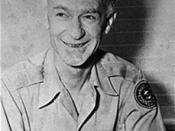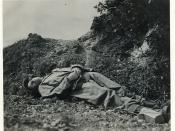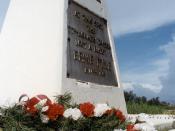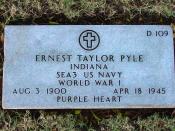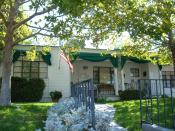Ernie Pyle By: Jenny Trembath March 20, 2000 Ernie Plye When a machine-gun bullet ended the life of Ernie Pyle in the final days of World War II, Americans spoke of him in the same breath as they had Franklin Roosevelt. To millions, the loss of him was as great as the loss of the wartime president.
Since WWII correspondent Ernie Pyle was so famous, his death on the battlefront came as a shock to people around the world.
Ernest Taylor Pyle was born August 3, 1900 to Will and Marie Pyle. He was born an only child on the Same Elder farm just southwest of Dana, Indiana. His father, Will Pyle, was a tenant farmer because he couldn't make a steady living from being a carpenter, which is what he really liked to do. Pyle described his father, "He never said a great deal to me all his life, and yet I feel we have been very good friends, he never gave me much advice or told me to do this or that, or not to."
Marie Pyle filled the role of family leader. She enjoyed tasks at hand: raising chickens and produce, caring for her family and serving the neighbors. Pyle describes her, "She thrived on action, she would rather milk than sew; rather plow than bake" (Tobin 6).
Through school Pyle loved to write. During high school he was reporter, then editor, then editor in chief for his high school newspaper. When he graduated high school, he too was caught up in the "patriotic fever" of the nation upon America's entry into WWI (Whitman 2). He enlisted in the Naval Reserve but before he could finish his training an armistice was declared in Europe. After that he attended the University of Indiana to study journalism, but left before he graduated.
Ernie Pyle persued his love for writing, and became a cub reporter for "LaPorte Herald." For months later he was offered a $2.50-per-week raise to work for the "Washington Daily News." He wrote the countries first daily aviation column for four years before becoming the papers managing editor. Pyle was a reporter, copy editor, and aviation editor until 1932, when he accepted a job for the "Scripps-Howard" newspaper chain. Pyle loved to travel and persuaded Scripps-Howard executives to allow him to be a roving reporter. Ernie Pyle was very excited to be a roving reporter: It's better than a million dollars. It's a new job, the best job in the world. Just think! No more sitting behind a desk! No more sticking to the same old office! No more writing headlines of editing other people's stories (Wilson 66).
The six years he was a roving reporter for "Scripps-Howard he crossed the continent some 35 times. He wrote about all kinds of things: mountain climbing, making soap, digging for gold, zippers that stuck, and his folks back home. Whenever he found a good story, he stopped for a day or two. He would talk to all kinds of people. The he would write his story in a hotel room that night. People that read his column described it as just like receiving a letter (Wilson 65).
In 1940 Ernie Pyle went to England to report on the Battle of Britain. In 1941 he began covering America's involvement in WWII, reporting on Allied operations in North Africa, Sicily, Italy, and France. Pyle's column during WWII reported on the life and sometimes death of the average soldier to the millions of the American home front. He had a simple, warm, human writing style. He was widely popular, especially during WWII.
Pyle's columns covered almost every branch of the service from quarter-master troops to pilots. He saved his highest praise for the common foot soldier, "I love the infantry because they are the underdogs. They are the mud-rain-frost-and-wind boys. They have no comforts and they even learn to live without necessities. And in the end they are the guys that wars can't be won without" (Wilson 66). His columns which eventually appeared in 200 newspapers did more than just inform. In 1944 Pyle proposed that combat soldiers be given "fight pay" similar to an airman's flight pay. In May of that year Congress acted on Pyle's suggestion and gave soldiers 50% extra pay for combat service. Also in 1944 Pyle was awarded Pulitzer Prize in reporting for his distinguished reports from the European battlefront.
Ernie Pyle showed his bravery through doing the job he did even though he hated war. After he died a column he wrote about his hatred for war was found in his pocket: The unnatural sight of cold dead men scattered over the hillsides and in the ditches along the high rows of hedge throughout the world. Dead men by mass production in one country after another. Month after month and year after year. Dead men in winter and dead men in summer. Dead men promiscuity that they become monotonous. Dead men in such monstrous infinity that you come to almost hate them.
In 1945 Pyle went to "the Pacific theater," his last assignment from "Scripps-Howard." One year after receiving the Pulitzer Prize he was killed by Japanese machine-gun fire. He died in Ie Shima, a small island west of Okinawa while traveling with a group of infantrymen.
When Pyle died his column was in 400 daily newspapers and 300 weekly newspapers. The soldiers paid tribute to him with a simple plaque reading, "At this spot, the 77th Infantry Division lost a buddy, Ernie Pyle, 18 April 1945." Since then Ernie Pyle's birthplace home was moved from it's rural site to its present location and became a state historic site in July, 1976.
Ernie Pyle was known by many people and his death during World War II was a shock. His bravery was shown and people around the world appreciated it.
Works Cited 1. Tobin, James. Ernie Pyle's War: America's Eyewitness To World War II. New York: The Free Press, 1997.
2. Whitman, Mark. "Ernie Pyle." Access Indiana Teaching and Learning Center. 1997. 5 March 2000 3. Wilson, Ellen. Ernie Pyle: Boy From Back Home. Indianapolis: The Bobbs-Merrill Company Inc., 1955.
Bibliography 1. "Ernie Pyle." Microsoft Encarta Encyclopedia 2000. CD-ROM. 2000 ed.
2. "Ernie Pyle State Historic Site." Indiana State Museum and Historic Sites. 2 March 2000 3. Tobin, James. Ernie Pyle's War: America's Eyewitness To World War II. New York: The Free Press, 1997.
4. Whitman, Mark. "Ernie Pyle." Access Indiana Teaching and Learning Center. 1997. 5 March 2000 5 Wilson, Ellen. Ernie Pyle: Boy From Back Home. Indianapolis
